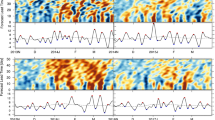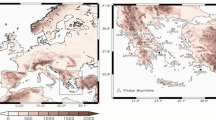Abstract
In this paper, the ability of the CFSv2 model to forecast the polar vortex displacements in the stratosphere of the Northern hemisphere is evaluated. We use the ERA-I reanalysis daily data of the potential vortex (pv) and the horizontal wind; vertical wind in the 430, 475, 530, and 600 K in the potential temperature field; and the temperature in the geopotential height at 50 hPa. And the 1–850 hPa isobaric surface temperature and u, v wind field daily data from the 9-month business forecast data of the Climate Forecast System Version 2 (CFSv2). The two polar vortex displacement events shift to Eurasia that occurred in Feb 2008 and Jan 2012. The results show that the polar vortex displacement events in February 2008 and January 2012 shifted toward the European region. During the polar vortex displacements, the westerly wind at 60°N latitude decreases, the temperature gradient reverses at the north polar and 60°N latitudes at 50 hPa, and a weaker stratospheric warming occurs in this process. For two of the polar vortex displacement events, the CFSv2 predictions of the start, largest, and end times of the polar vortex displacement are accurate at forecast lead times of 0 and 5 days, and the prediction results for the westerly winds and temperature gradients are also excellent. However, the CFSv2 prediction ability at forecast lead times exceeding 20 days is poor. For the polar vortex displacement event in February 2008, the CFSv2 predictions are good for the start and largest times but are not consistent with the actual situation for the end time at a forecast lead time of 10 days. The CFSv2 predictions are good for the end time but are not accurate for the start and largest times at a forecast lead time of 15 days. For the polar vortex displacement event in January 2012, the CFSv2 predictions are poor for the start, largest and end times and for the zonal wind, but are good for the temperature gradient during the displacement at forecast lead times of 10 days. The change in the polar vortex boundary and zonal wind and temperature gradients cannot be predicted at forecast lead times of 15 days.










Similar content being viewed by others
References
Andrews DG, Holton JR, Leovy CB (1987) Middle atmosphere dynamics (p. 489). Academic Press, San Diego, CA
Baldwin MP, Dunkerton TJ (2001) Stratospheric harbingers of anomalous weather regimes[J]. Science 294(5542):581–584
Baldwin MP, Thompson DW (2009) A critical comparison of stratosphere–troposphere coupling indices. Q.J.R. Meteorol Soc 135:1661–1672
Black RX, McDaniel BA (2009) Submonthly polar vortex variability and stratosphere–troposphere coupling in the Arctic. J Clim 22(22):5886–5901
Black RX, McDaniel BA, Robinson WA (2006) Stratosphere–troposphere coupling during spring onset[J]. J Clim 19(19):4891–4901
Butler AH, Seidel DJ, Hardiman SC, Butchart N, Birner T, Match A (2015) DEFINING SUDDEN STRATOSPHERIC WARMINGS. Bull Am Meteorol Soc 96(11)
Castanheira JM, Barriopedro D (2010) Dynamical connection between tropospheric blockings and stratospheric polar vortex. Geophys Res Lett 37(13)
Christiansen B (2001) Downward propagation of zonal mean zonal wind anomalies from the stratosphere to the troposphere. Model Reanal 106(D21):27307–27322
Guokun DAI, Mu MU (2020) Influence of the Arctic on the Predictability of Eurasian Winter Extreme Weather Events. Adv Atmos Sci 37(04):307–317
Huang J (2019) The Connection between the arctic stratospheric polar vortex variability and the anomalous tropospheric weather during Northern Winter. [D]. Lanzhou University.
Huang J, Tian W, Gray LJ, Zhang J, Li Y, Luo J, Tian H (2018) Preconditioning of Arctic stratospheric polar vortex shift events. J Clim 31(14):5417–5436
Karpechko AY (2018) Predictability of sudden stratospheric warmings in the ECMWF extended-range forecast system. Mon Weather Rev 146(4):1063–1075
Kuttippurath J, Nikulin G (2012) A comparative study of the major sudden stratospheric warmings in the. Arctic Winters 2003/2004-2009/2010 12(279):8115–8129
Li W, Jinhui C, Yanjun G, Min L (2010) Global significant weather and climate events in 2009. Meteorol Monthly 36(04):106–110
Li W, Li Y, Chen L et al (2013) Inter-decadal variability of the relationship between winter temperature in China and its impact factors. J Appl Meteorol Sci 24:385–396
Lorenz EN (1963) Deterministic Nonperiodic Flow. J Atmos Sci 20:130–141
Marshall AG, Scaife AA (2010) Improved predictability of stratospheric sudden warming events in an atmospheric general circulation model with enhanced stratospheric resolution. J Geophys Res Atmos 115(D16)
Mitchell DM, Gray LJ, Anstey J, Baldwin MP (2013) The influence of stratospheric vortex displacements and splits on surface climate. J Clim 26:2668–2682
Nash ER, Newman PA, Rosenfield JE, Schoeberl MR (1996) An objective determination of the polar vortex using Ertel’s potential vorticity. J Geophys Res-Atmos 101(D5):9471–9478
Seviour WJM, Mitchell DM, Gray LJ (2013) A practical method to identify displaced and split stratospheric polar vortex events. Geophys Res Lett 40(19):5268–5273
Seviour WJM, Gray LJ, Mitchell DM (2016) Stratospheric polar vortex splits and displacements in the high-top CMIP5 climate models. J Geophys Res-Atmos 121(4):1400–1413
Shepherd TG (2016) Effects of a warming Arctic. ENCE 353(6303):989–990
Stocker TF, Qin D, Plattner G-KM et al (2013) Ipcc, 2013: Climate Change 2013: The Physical Science Basis. Contribution of Working Group I to the Fifth Assessment Report of the Intergovernmental Panel on Climate Change. Comput Geom 18(2):95–123
Taguchi M (2014) Stratospheric predictability: basic characteristics in JMA 1-Month Hindcast Experiments for 1979–2009. J Atmos Sci 71(9):3521–3538
Tripathi OP, Baldwin M, Charlton-Perez A, Charron M, Eckermann SD, Gerber E, Harrison RG, Jackson DR, Kim BM, Kuroda Y, Lang A, Mahmood S, Mizuta R, Roff G, Sigmond M, Son SW (2015) The predictability of the extratropical stratosphere on monthly time-scales and its impact on the skill of tropospheric forecasts. Q J R Meteorol Soc 141(689):987–1003
Vignon E, Mitchell DM (2015) The stratopause evolution during different types of sudden stratospheric warming event. Clim Dyn 44:3323–3337
Yi M (2009) Study on Anomaly of stratospheric polar vortex and its impact on troposphere. Doctor dissertation of the university of science and technology of China
Yihui D, Ma X (2007) Isentropic potential vortex analysis of severe cold wave events in winter 2004/2005. Acta Meteorol Sin 05:695–707
Zuev VV, Savelieva E (2019) The cause of the spring strengthening of the Antarctic polar vortex. Dyn Atmos Oceans 87:101097
Acknowledgments
This work the ERA-I reanalysis data provided by the ECMWF, were acquired from their website at https://apps.ecmwf.int/datasets/data/interim-full-daily/levtype = pt/. The CFSv2 model at forecast lead times of 0, 5, 10, 15, 20, 25, and 30 days before the beginning date were acquired from https://www.ncdc.noaa.gov/data-access/model-data/model-datasets/climate-forecast-system-version2-cfsv2#CFS%20Reforecasts. The authors are grateful to the European Centre for Medium-Range Weather Forecasts (ECMWF) and the National Center of Environmental Prediction (NCEP) for making these data available.
Funding
This work was jointly funded by the National Key
R&D Program of China (2017YFC1502301) and the National Natural
Science Foundation of China (41875089).
Author information
Authors and Affiliations
Contributions
Conceptualization: Yajing Liu, Zhigang Wei; Methodology: Yajing liu, Zhigang Wei; Formal analysis and investigation: Yajing Liu; Writing—original draft preparation: Yajing Liu; Writing—review and editing: Yujia Liu, Xianru Li, Huan Wang, Guangyu Chen, Zhiyuan Zheng; Funding acquisition: Zhigang Wei.
Corresponding author
Ethics declarations
Conflict of interest
The authors declare that they have no conflict of interest.
Availability of data and material
This work the ERA-I reanalysis data provided by the ECMWF, were acquired from their website at https://apps.ecmwf.int/datasets/data/interim-full-daily/levtype = pt/. The CFSv2 model at forecast lead times of 0, 5, 10, 15, 20, 25, and 30 days before the beginning date were acquired from https://www.ncdc.noaa.gov/data-access/model-data/model-datasets/climate-forecast-system-version2-cfsv2#CFS%20Reforecasts.
Code availability
Not applicable.
Additional information
Publisher’s note
Springer Nature remains neutral with regard to jurisdictional claims in published maps and institutional affiliations.
Rights and permissions
About this article
Cite this article
Liu, Y., Wei, Z., Liu, Y. et al. Evaluation of the ability of CFSv2 to forecast polar vortex displacements in the stratosphere of the Northern hemisphere. Theor Appl Climatol 143, 1167–1179 (2021). https://doi.org/10.1007/s00704-020-03507-7
Received:
Accepted:
Published:
Issue Date:
DOI: https://doi.org/10.1007/s00704-020-03507-7




